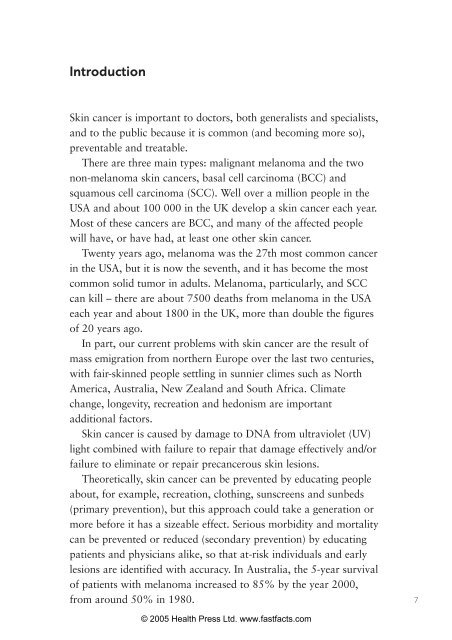You also want an ePaper? Increase the reach of your titles
YUMPU automatically turns print PDFs into web optimized ePapers that Google loves.
Introduction<br />
<strong>Skin</strong> cancer is important to doctors, both generalists and specialists,<br />
and to the public because it is common (and becoming more so),<br />
preventable and treatable.<br />
There are three main types: malignant melanoma and the two<br />
non-melanoma skin cancers, basal cell carcinoma (BCC) and<br />
squamous cell carcinoma (SCC). Well over a million people in the<br />
USA and about 100 000 in the UK develop a skin cancer each year.<br />
Most of these cancers are BCC, and many of the affected people<br />
will have, or have had, at least one other skin cancer.<br />
Twenty years ago, melanoma was the 27th most common cancer<br />
in the USA, but it is now the seventh, and it has become the most<br />
common solid tumor in adults. Melanoma, particularly, and SCC<br />
can kill – there are about 7500 deaths from melanoma in the USA<br />
each year and about 1800 in the UK, more than double the figures<br />
of 20 years ago.<br />
In part, our current problems with skin cancer are the result of<br />
mass emigration from northern Europe over the last two centuries,<br />
with fair-skinned people settling in sunnier climes such as North<br />
America, Australia, New Zealand and South Africa. Climate<br />
change, longevity, recreation and hedonism are important<br />
additional factors.<br />
<strong>Skin</strong> cancer is caused by damage to DNA from ultraviolet (UV)<br />
light combined with failure to repair that damage effectively and/or<br />
failure to eliminate or repair precancerous skin lesions.<br />
Theoretically, skin cancer can be prevented by educating people<br />
about, for example, recreation, clothing, sunscreens and sunbeds<br />
(primary prevention), but this approach could take a generation or<br />
more before it has a sizeable effect. Serious morbidity and mortality<br />
can be prevented or reduced (secondary prevention) by educating<br />
patients and physicians alike, so that at-risk individuals and early<br />
lesions are identified with accuracy. In Australia, the 5-year survival<br />
of patients with melanoma increased to 85% by the year 2000,<br />
from around 50% in 1980. 7<br />
© 2005 Health Press Ltd. www.fastfacts.com















